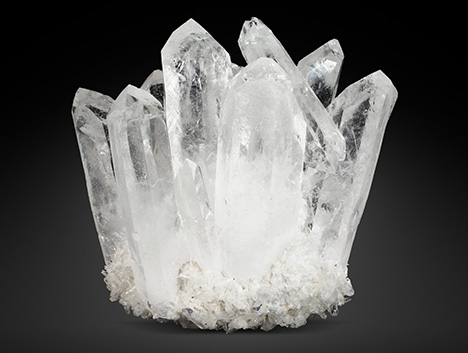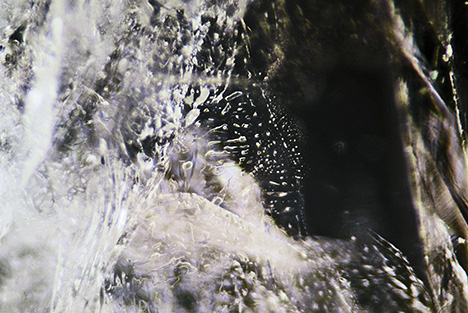Synthetic Rock Crystal Quartz Cluster with Natural-Looking Inclusions

A client recently submitted for identification the piece shown in figure 1, assuming it to be a natural mineral specimen. It weighed 1114 g, measured 119 × 126 mm, and contained colorless transparent to semitransparent crystals. Eye-visible inclusions as well as numerous tiny crystals and some minute powdered material were seen around the cluster’s base.


Standard gemological testing yielded a refractive index of 1.542–1.555, a specific gravity of 2.65, and inert reactions under long- and short-wave UV radiation, properties consistent with quartz. Microscopic examination revealed obvious fluid and two-phase inclusions (figure 2). Examination by Fourier-transform infrared (FTIR) spectroscopy showed an absorbance region in the 400–1600 cm–1 range, also consistent with quartz, and Raman spectroscopy confirmed the identification. However, the most important data came from the FTIR analysis in transmission mode in the 1000–6000 cm–1 range. A characteristic peak of synthetic quartz at 3584 cm–1 (figure 3) was observed, while peaks consistent with natural quartz (3378, 3482, and 3595 cm–1) were not detected. Similar spectra were collected from the other crystals in the group, confirming a synthetic origin (S. Karampelas et al., “Infrared spectroscopy of natural vs. synthetic amethyst: An update,” Fall 2011 G&G, pp. 196–201; Winter 2015 Lab Notes, pp. 439–440).

Synthetic quartz crystal clusters are not new to the market, but as the use of synthetic quartz has increased, such crystal specimens have become available on numerous online shopping platforms. Surprisingly, most of them are sold as “natural quartz clusters.” One of the common trade methods for separating natural and synthetic quartz clusters is to observe the striations on the prism faces. In natural quartz, the striations form horizontally (perpendicular to the c-axis), while synthetic quartz typically displays diagonal or triangular striations (figure 4) (Winter 2016 G&G Micro-World, pp. 425–426). This method may aid in identification but should not be considered diagnostic, since the striations can be faked.
When synthetic quartz clusters are fashioned into polished products, the potential of misidentifying them as “natural quartz” increases significantly, especially with inexperienced consumers and small-scale labs lacking analytical equipment. In such cases, the inclusion scene is almost identical to that observed in natural quartz, and the helpful prismatic face growth lines disappear. Therefore, members of the trade should be cautious when handling synthetic quartz, although the crystal clusters may be somewhat easier to identify.



